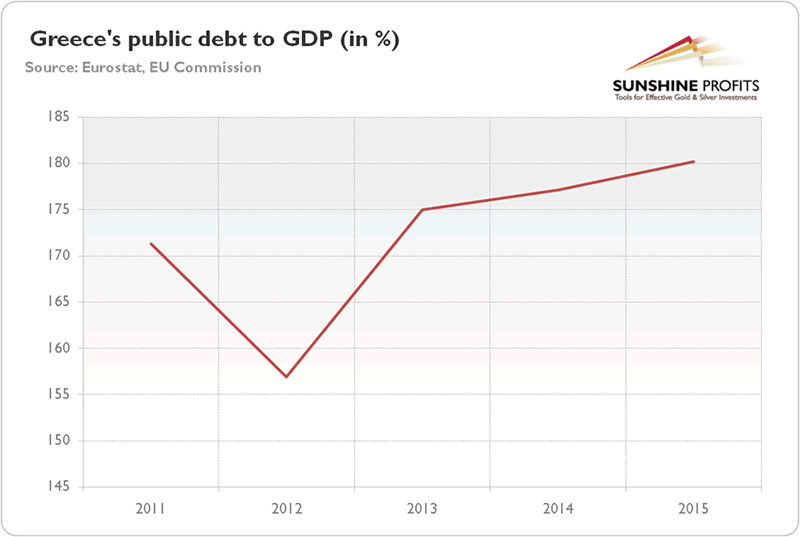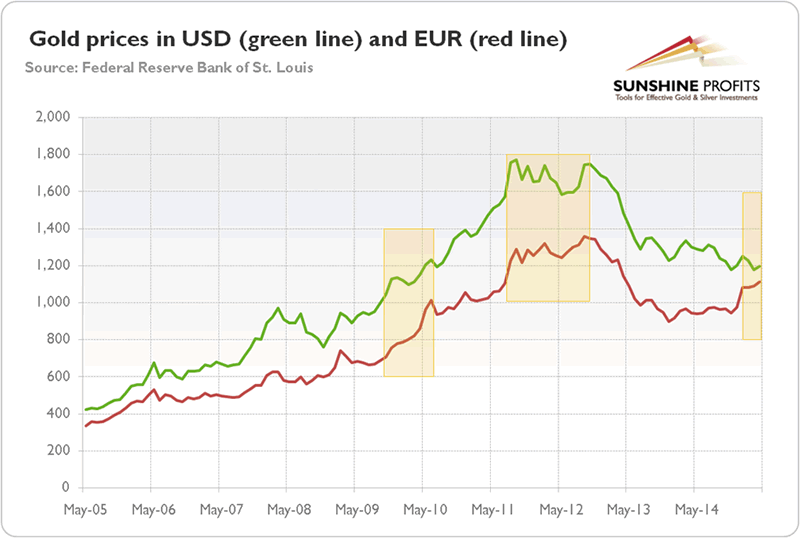Greece’s Current Debt Problems
Interest-Rates / Eurozone Debt Crisis Jun 06, 2015 - 10:50 AM GMTBy: Arkadiusz_Sieron

 Greece is again on the brink. Hellas stood on the edge for the first time in spring 2010. In May 2010 the European Union and International Monetary Fund approved the first bailout worth €110 billion, under the condition of austerity measures. The first rescue package missed its targets as lenders’ economic forecasts for Greece were too optimistic. Therefore, in February 2012 the Troika (the Eurogroup, the European Central Bank and the International Monetary Fund) finalized the second rescue package worth a €173 billion (including money left over from the first bailout) provided by the newly created European Financial Stability Facility.
Greece is again on the brink. Hellas stood on the edge for the first time in spring 2010. In May 2010 the European Union and International Monetary Fund approved the first bailout worth €110 billion, under the condition of austerity measures. The first rescue package missed its targets as lenders’ economic forecasts for Greece were too optimistic. Therefore, in February 2012 the Troika (the Eurogroup, the European Central Bank and the International Monetary Fund) finalized the second rescue package worth a €173 billion (including money left over from the first bailout) provided by the newly created European Financial Stability Facility.
The agreement implied austerity measures and included the extension of the repayment period to 15 years, the lowering of the interest rate to 3.5 percent and a 53.5 percent haircut accepted by the private bondholders. The write-down was applied to €198 billion of Greek bonds, making it the biggest debt default in history.
The last part of the Greek tragedy began when Syriza won the general election in January 2015. This radical-left party wanted to challenge the logic of the bailout deal and opposed an extension of the bailout program that ended February 28. Eventually, the bailout program for Greece was extended – in return for Greece’s commitment to honor its debt obligations and conduct structural reforms –within four months (the end of June), just weeks before Greece’s due date to make several large debt repayments.
What are the current economic difficulties of Greece? The main problem is quite simple: Greece does not have enough income to pay its bills. Hellas has to pay off over €1.5 billion to the IMF in June and €7 billion to the ECB to repay government bonds (including interest), which mature in July and August. It does not mean that the country will immediately default without unblocking the last €7.2 billion tranche of the current bailout program. Greece managed to improve its budget in the first quarter of 2015. However, according to Silvia Merler, the improvement was achieved mainly by “postponing payments to suppliers (e.g., to the hospitals – note ours) which can be efficient in improving the budget in the short term, but the postponement of state payments to suppliers may hurt the real economy even further”. Indeed, Greece’s economy fell into recession again in the first quarter as its GDP contracted by 0.2 percent, after shrinking 0.4 percent in the previous period. Moreover, to make the last payment to the IMF, Greece had to use its special drawing rights (held at the IMF) and to borrow money from different parts of the state administration, public enterprises and pension funds. Thus, it seems likely that the government will struggle to make payments twice as large. Economists believe that Hellas will probably survive until July 20, when it has to make the €3.5 billion payment to the ECB. According to Peter Spiegel, Greece needs a third bailout of as much as €37.8 billion.
The public finances are not the only problem. The Greek banks are facing bad loans, deposit outflows and are running out of the collateral they need to survive. And the Hellas’ bad financial situation is aggravated by the debt servicing costs. Greece’s debt is the highest in the Eurozone and it will reach 180.2 percent of the GDP this year (see the chart 1).

Chart 1: Greece’s general government gross debt to GDP (in %) between 2011 and 2015
However, contrary to popular opinion, the debt-servicing burden is not excessive, compared to other countries and historical cases. This is because creditors lowered interest rates and extended loan maturities (the average maturity of Greece’s debt is now 16.5 years, double that of Germany and Italy). Interest payments fell from 7.3 percent of GDP in 2011 to 4.3 percent of GDP in 2014 (and subtracting interest payments refunded and deferred, Greece already has to pay only 2.6 percent), similar to 4.4 percent in the case of Ireland in 2013, 4.8 percent in the case of Italy and 5 percent in case of Portugal. Therefore, Greece pays less than the countries with much lower debt-to GDP ratios; however the payments falling due this year are the real issue.
The truth is that the Greek government is simply not willing to repay the debt in full, especially with an economy that is falling into recession. It could do it, for example, by selling its assets, by deregulating and liberalizing its economy to revive totally uncompetitive exports(Greece is the least competitive economy in the Eurozone), or by reforming its pension system, which costs 17.5 percent of the GDP, while the average pension expenditures in the Eurozone amount to the 13.8 percent of the GDP. However, it won’t, just because it believes that Greece has been a victim of excessive austerity.
To sum up, the Greek government will struggle to make payments which fall due in July and August. It seems unlikely that Hellas will manage to repay its summer debt obligations without the agreement of its creditors or a significant drag on its real economy (in the form of default on obligations against its suppliers and employees). However, even a new rescue package will not help, because Greece – as the last Soviet-style economy in Europe – is a bottle without a bottom. Therefore, a sustainable solution is not possible without substantial reforms in Greece.
Thus, it seems that in the nearest future Greece’s debt crisis will be a supportive factor for gold prices. Fears over Greece should increase in the coming days, so then the gold prices, as the yellow metal will be bought as a safe haven or a hedge against the financial turmoil that could follow a Greek default. This was the case in 2010, when the Greek crisis led to safe-haven buying and supported gold prices, and also in 2012, when the gold price peaked around the time that Grexit fears were at their highest (see the chart no. 2). On the other hand, if fears diminish– for example, because the new bailout package will eventually be finalized–gold prices will probably decrease.

Chart 2: Gold prices in USD (green line) and EUR (red line) between May 2005 and April 2015 with selected periods of highest Grexit fears.
If you enjoyed the above analysis, we invite you to read the full version of this report - in our June Market Overview report we analyzed the relationship between Hellas’ problems and the gold market, as well as possible scenarios for the Greece’s crisis. We also encourage you to stay updated on the latest gold-related global developments by joining our gold newsletter. It's free and you can unsubscribe anytime.
Thank you.
Arkadiusz Sieron
Sunshine Profits‘ Market Overview Editor
Disclaimer
All essays, research and information found above represent analyses and opinions of Przemyslaw Radomski, CFA and Sunshine Profits' associates only. As such, it may prove wrong and be a subject to change without notice. Opinions and analyses were based on data available to authors of respective essays at the time of writing. Although the information provided above is based on careful research and sources that are believed to be accurate, Przemyslaw Radomski, CFA and his associates do not guarantee the accuracy or thoroughness of the data or information reported. The opinions published above are neither an offer nor a recommendation to purchase or sell any securities. Mr. Radomski is not a Registered Securities Advisor. By reading Przemyslaw Radomski's, CFA reports you fully agree that he will not be held responsible or liable for any decisions you make regarding any information provided in these reports. Investing, trading and speculation in any financial markets may involve high risk of loss. Przemyslaw Radomski, CFA, Sunshine Profits' employees and affiliates as well as members of their families may have a short or long position in any securities, including those mentioned in any of the reports or essays, and may make additional purchases and/or sales of those securities without notice.
Arkadiusz Sieron Archive |
© 2005-2022 http://www.MarketOracle.co.uk - The Market Oracle is a FREE Daily Financial Markets Analysis & Forecasting online publication.


